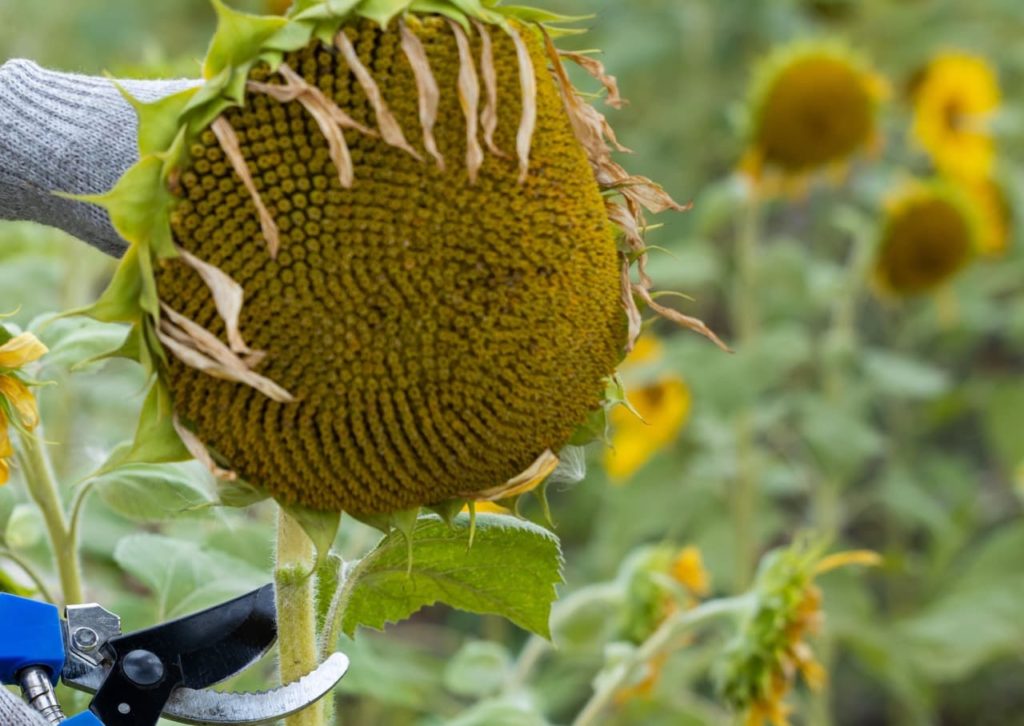yearly > SUNFLOWER > DEADHEADING
IN THIS GUIDE
SUNFLOWER GUIDES

Container GrowingDeadheadingDroopingHarvestingSowingSupportVarieties
Many people regard deadheading as a tiresome and unnecessary activity , and it is true that your sunflowers will come through just fine if you jump it .
However , there are a boniface of benefits to be savor by drop a few minutes doing so once or double during the flower time of year .

All it command is just a little investiture of time , following these individual step :
For those who still do n’t feel convinced take on the task from these instructions alone , I ’ve delved into each step in great detail below .
Why Deadhead Sunflowers?
The main advantage of deadheading is bring a halt to germ production .
Why is this desirable ?
Well , it will divert the plant ’s energies back towards bloom , ensuring a long flowering time of year .

“ Large exclusive - headed sunflowers will not involve deadheading , but many sunflowers will typically have many smaller peak that will benefit after the first , often larger , flowers have bloomed , ” says Colin Skelly , a Horticultural Consultant .
“ Deadheading will extend the time of year and ply many low flush head for seminal fluid saving or wildlife . ”
It will also prevent ego - seeding which will make the helianthus less attractive to pests .

Finally , deadheading also carries the benefit of keeping your sunflower exhibit neat and respectable .
1) Sanitise Your Tools
Speaking from personal experience , there ’s nothing worse than trying to exsert your plant ’s blooming cycle , but actually jeopardize its life through the spread of bacterium !
For that cause , sanitising your tools is of paramount importance .
2) Get The Timing Right
Successfully deadheading sunflowers involves removing fading blooms before they have a hazard to grow seeds .
This means being pitiless with any bloom that do n’t quite await their good , that have been gnawed at by plague or that are jostle for space with other healthier blossoms .
On the other handwriting , if you bid to save the seeds for extension or bird - feed purposes , you’re able to waitress until the reverse of the helianthus head has bend chicken .

redeem these after cut back and pay heed them upside down in a teetotal location with good ventilation to allow the source to fully mature .
3) Identify The First Set Of Leaves
Once you have identify the sunflower you ’re going to deadhead , take care down its stem to locate the first set of leave that sprout from the stem turn beneath the blossom head .
This is where you ’ll make the cut .
If the sunflower in your care is a multi - caulescent variety , you ’ll want to take over this summons with every individual sunflower and front down at it to ascertain where it splits off from the main stalk .

4) Make The Incision
With one hand , comprehend the root firmly but lightly to ensure you do n’t by chance exterminate or otherwise damage the plant .
With the other , use your pruners to make the prick just above the leaf node .
You should make the incision at a 45 ° slant or one close enough to that slope .

This will prevent rainfall from accumulate atop the radical and from adversely damage the plant ’s health .
5) Sweep Any Debris
Once you have end up deadheading , it ’s highly important to remember to drag up all the flower heads , stems and foliage that have fallen from it during the outgrowth .
There are a number of ground why this is a sensible increase to your subprogram .
first off , throw away of the debris will make the plant life look kempt and more attractive , as well as improve air circulation and reduce the chance of fungal infections .

What ’s more , it will alsogive you access to any seedsinside the drop bloom heads if you wish to glean them , or at least some good - calibre constitutive stuff for composting if you do n’t .
6) Repeat Later In The Season
Depending on the cultivar of helianthus you have choose , the growing conditions in your garden , and the mood in that fussy year , you might witness that deadheading your sunflower just once is enough to ensure they enjoy a long and happy flower season .
However , robust plants in optimum conditions will replace the blooms you have removed with reasonable quickness .
For this reason , I always care to perform an initial deadheading round in mid to late summer , before take over the operation again in autumn .
That means , I keep my plants looking impressive for as long as potential .